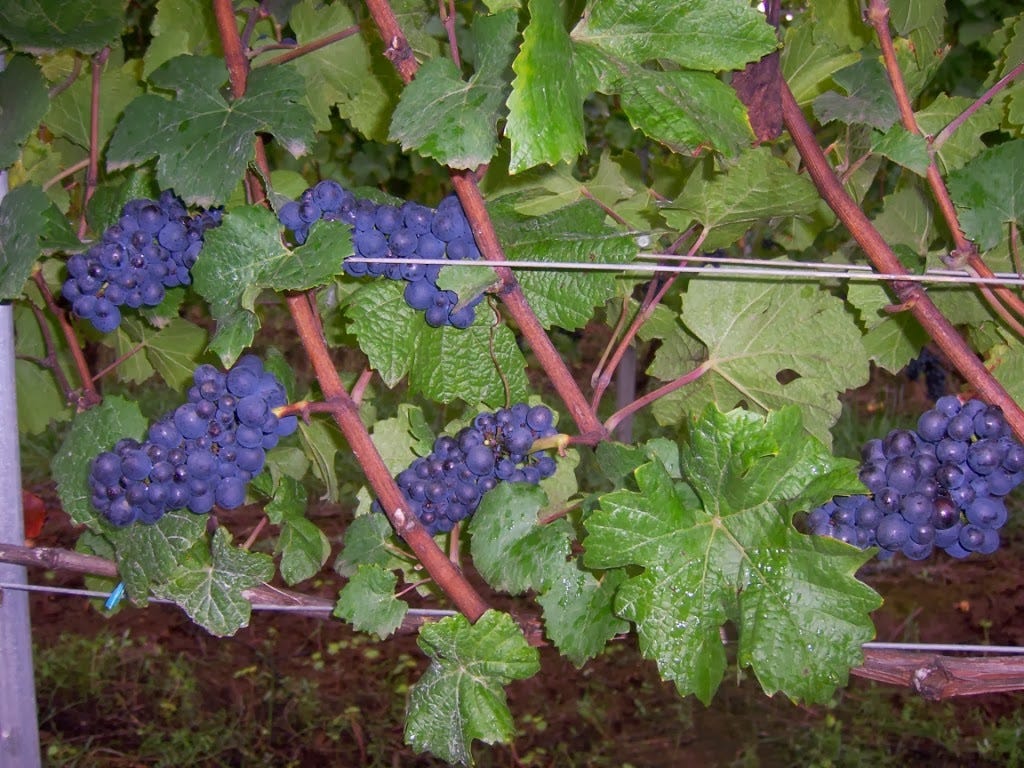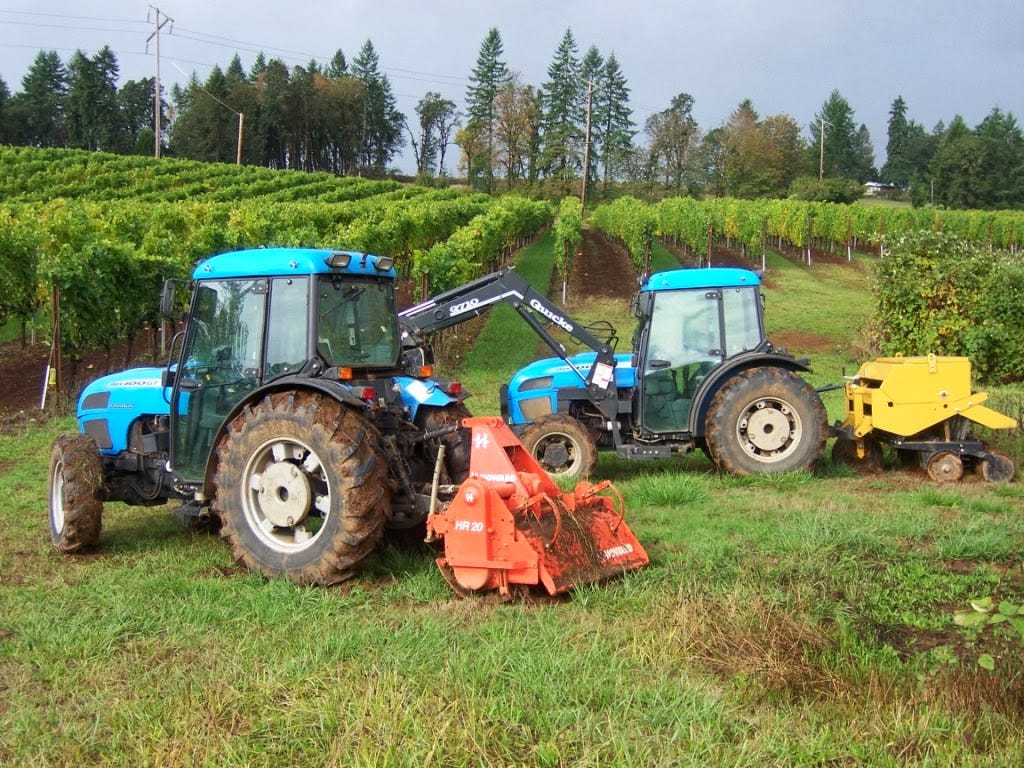Amalie Robert Estate Climate Update: 2013 September
Hello and Welcome,
This is the climate update for the month of September 2013, such that it is.
“From here on in anything could happen and probably will.”
– Amalie Robert Estate Mid-September 2013 Climate Update
There is a technical farming term to accurately and succinctly describe the second half of September. It is not a term we can publish, but we will give you a hint – it rhymes with “Kitty.”
The vintage was rolling right along through the third week of September. We had a little shower early in the month to wash off the dust and give the vines a little soil moisture to finish their work of ripening seeds. A quick cluster sample gave us a clue, we were not ready. That, and the tell tale walnut tree was still holding green. It usually starts to senesce into a beautiful yellow torch when it is time to bring in the fruit.
The cluster sample provided us with a quick reading of sugars and acids. We saw the sugars were moderate in the 22 Brix range. This is the middle ground between 20 and 24 and provides an alcohol estimate of about 13 percent. If you just knew the number without the weather context you would be ready to cluster pluck. The other shoe dropped when we took a look at the pH. It was close to 3.25 which is historically very low (acidic) for our vineyard and the way we grow our wine.
All together now: “What does that mean and why should I care!?”
It means that we had another spot of rain before we were able to take the cluster sample. To look at the clusters, you would see the wineberries were fully pumped up with juice. That juice is now containing a higher percentage of water. So instead of reading 25 Brix and making 15% alcohol wines, we are bending the sugar curve down. The water diluted our sugars and we like that.
So why not pick ‘em? The acids as measured by the pH meter are also diluted. A pH of 3.25 is pretty low (acidic) for our Pinot Noir. Now consider where we were before the last cloud outburst. Take a bit of that water out of that berry and you would see a higher concentration of acid, maybe adjusting the pH down to 3.15. This tells us the wineberries have not completed their ripening program as indicated by high acids.
For several reasons, but only one we will elaborate on here, we simply cannot imagine making wine from someone else’s fruit. Each of our 36 blocks has their own little idiosyncrasies and unique characteristics that we are intimately familiar with. These all come into play when making a harvest decision to go or to wait.
One key factor of our winegrowing program has a significant impact on acids and that is our leaf pull regime. We pull very few leaves in our Pinot Noir because we will be fermenting those wineberries with a portion of the stems. Yes, this is a WTF (Waft The Fruit) moment.

Wineberries exposed to the sun develop aromas, flavors and phenolics (tannin.) Like most things in life that taste good, you can have too much of a good thing here. Excessive sun exposure will develop harsh or astringent tannins in the wine. A little more shading will temper this development into more sexy and sublime aromas and flavors with moderate tannins.
Here is where the whole clusters come into play. The stems that the wineberries are maturing on are a woody structure of the vine. We add a portion of our fruit to the fermenter “on the stem.” That means these stems are in the fermenter adding a bit of flavor and tannin complexity of their own. They also add a fair bit of astringency.
You can do this experiment in the privacy of your own home with a bunch of table grapes. Remove the grapes from the stem and chew on it. It should not take long before you will be experiencing the influence of whole cluster fermentation. Remember to say “Kitty!”
OK, let’s bring it home. Shading our fruit allows us to develop a more elegant aroma and flavor profile in our wines without the harsh tannin of overexposed wineberries. The stem adds a little astringent tannin to give our wines a strong backbone. We then go into barrel for 18 months to soften that astringency, a bit. The result is a well balanced tannin structure that, paired with firm acidity, is the secret to long lived wines that will continue to develop intriguing aromas, flavors and textures.
So, what does this have to do with pH? Wineberries grown in a more shaded canopy have a higher pH. We typically see our pH rise to well over 3.50 before harvest. So when we see a pH reading of 3.25, and it is diluted due to a little rain, we know they are not ready for the big cluster pluck.
And of course, there is more to the story. The skins still taste like green bananas when you chew them. The seeds are almost martini olive green, but not quite. And there is still a fair bit of gelatinous pulp around the seeds. This should be mostly gone in a fully flavored and “aroma-ed” wineberry. Ergo, they are not ready
And then it rained.
The old timers around here, after a bit of prodding, will tell you about 1984. That was the year the waterworks started in September and simply did not stop. They will talk about harvesting with “Oregon Buckets.” These are buckets that have drainage holes drilled in the bottoms to let the rainwater out. For you collectors out there, try and find a bottle of 1984 vintage Oregon Pinot Noir. Take your time. If you do find one, it will be a rare treat indeed as very little red wine was made that year. Then again, some things are better to want than to have.
And it kept raining.

It seems the Japanese do have some influence and control over Oregon Pinot Noir. The weather system that provided a seemingly unending supply of rain was fueled by Typhoon Pabuk. Typhoon Pabuk was heading to Japanfor a little R&R (rain and ruin.) But, a typhoon is typically not the stealthiest weather pattern and it was detected just in time. A strong weather front gathered itself together from the mainland, pushed over the Sea of Japan and confronted Typhoon Pabuk in the Pacific Ocean. Apparently, there were some issues surrounding diplomatic protocol and bringing in undeclared aquaculture products. In short order, Typhoon Pabuk was sent packing to the northeast.
It was windy too, which brought even more rain.
One man’s northeast is another man’s northwest. And that would happen to be where history found Ernie the weekend of September 28-29, 2013. The good news is the rototilling is all done. The alternate rows are ready for the winter cover crops that are selected to nourish our vines in the Spring and hold the soil in place during the winter rains. The bad news is that the cover crop is sitting in the seed drill waiting to be planted in the vineyard.

It was warm rain. Anyone have a Geiger counter?

And that seems to make sense. Typhoons are tropical events and if they are going to party, it is going to be with warm rain. Warm rain is not so good, and three days of warm rain is really … “Kitty.” Warm rain means we are about to experience a significant Botrytis event.
While we have been trying to keep dry, Botrytis has been loving the wet weather. Sure some of the spores are getting washed off. But the ones that had been on verge of compromising the fruit are well positioned to take over the entire cluster. This will happen the first week of October, when the sun is rumored to appear and crank up the heat. That’s gonna be a real big “Kitty.”
As we harvest, we will be very vigilant in keeping the Botrytis out of the fermenters. In that regard it will be very similar to a Burgundy harvest. The climate there often provides showers during the growing season that helps Botrytis get a foothold. They don’t have anything as cool as Typhoon Pabuk of course, but they do get Botrytis all the same.
At least the nets are up.
After several years of watching the birds feast on the more exposed areas of the vineyard, Ernie stopped wishing they would go away and just netted the vines. This was after abandoning the idea of tenting the vineyard like an aviary – hawks and all. In hindsight, the correct maneuver would have been to tarp the whole field.


The numbers are classified.
Let’s put it this way. If the government can figure out how to keep spending our money unabated, we will show you the numbers. Probably a pretty safe bet.
We are ready for harvest, as much as we can be. Ernie has selected a ¼ inch bit to start drilling holes in the harvest buckets. We have laid in harvest provisions and a 10 pound bag of whole bean “Dark Monster” to brew up every morning. Fresh wool socks and a new pair of Giorgio Farmani boots help keep everything moving along. After 14 years here if you don’t know how to dress for harvest, you don’t know Jac Shirt.
Kindest Regards,
Dena, Ernie and Typhoon Pabuk



